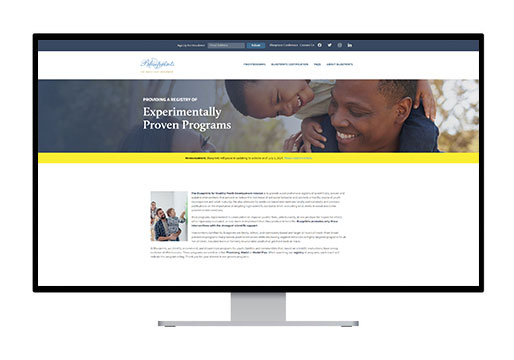A bullying prevention program that includes schoolwide, classroom, individual, and community strategies that create a safe and positive school climate, improve peer relations, and increase awareness of and reduce the opportunities and rewards for bullying behavior. This anti-bullying program offers activities designed for use in elementary, middle, junior and high schools.
Clearinghouse and Evidence Level
Blue Prints
The Blueprints for Healthy Youth Development mission is to provide a comprehensive registry of scientifically proven and scalable interventions that prevent or reduce the likelihood of antisocial behavior and promote a healthy course of youth development and adult maturity. We also advocate for evidence-based interventions locally and nationally and produce publications on the importance of adopting high-scientific standards when evaluating what works in social and crime prevention interventions.
Level 2
Moderate evidence from at least one well-designed and well-implemented quasi-experimental study.
Quick Stats
Content Focus Area
School Climate and Supports
Grade Band
Elementary School; Middle School; High School
Number of studies
3
Intervention Information
The information below provides details and characteristics of the intervention. The presented information is sourced from another clearinghouse. To learn more about the intervention, click through to the Source clearinghouse.
This page displays information on the population and settings in which studies were conducted on the intervention’s effectiveness. This means that the intervention has some level of positive evidence in the listed student populations and context. Remember to take your school’s context and population into consideration when selecting an intervention. Read more on selecting interventions.
| Resource Type | Program Evaluation | This presents the grade level of students represented in the reviewed studies for this intervention. On the OEBC, grade bands are categorized into four levels: Early Childhood (Birth-Age 5), Elementary School (Grades K-5), Middle School (Grades 6-8), and High School (Grades 9-12). |
|---|---|---|
| Subject Area | Not Listed | This refers to the school subjects: English Language Arts, Math, Science, and Social Studies. An intervention will be tagged with a subject if a reviewed study by the source clearinghouse has found that the intervention led to positive results in learning in that subject. |
| Setting | Not Listed | This presents the setting represented in the reviewed studies for this intervention. On the OEBC, setting has three categories: Rural, Urban, and Suburban. |
| Demographic |
| Demographic information refers to the student’s race/ethnicity and gender. It also includes information on subpopulations (e.g. Students with Disabilities, English Learners, Economically Disadvantaged, Justice Involved, and Foster Care). On the OEBC, an intervention is only tagged with demographic information if that intervention is specifically designed for, and has been reviewed on, that demographic. Please click through to the source clearinghouse to find total demographic breakdowns of all students who have taken part in a study on the intervention. |
| Training Needed | Listed | This indicates if the source clearinghouse has information on training needed to implement the intervention. | Length of Program or Delivery | Listed | This indicates if the source clearinghouse has information on how long the intervention takes to implement (e.g. session delivery time and/or how many days or weeks it takes to implement). |
| Cost | Listed | This indicates if the source clearinghouse has information on the cost to implement the intervention. |
| Effect Size | Listed | This indicates if the source clearinghouse provides an effect size for the intervention. Please visit the source clearinghouse to find the effect size and read more about the studies on this intervention. |
Studies Cited
- Olweus, D., & Alsaker, F. D. (1991). Assessing change in a cohort-longitudinal study with hierarchical data. In D. Magnusson, L.R. Bergman, G. Rudinger, & B. Torestad (Eds.), Problems and methods in longitudinal research: Stability and change (pp. 107-132). New York, NY: Cambridge University Press.
- Schroeder, B. A., Messina, A., Schroeder, D., Good, K., Barto, S., Saylor, J., & Masiello, M. (2011). The implementation of a statewide bullying prevention program: Preliminary findings from the field and the importance of coalitions. Health Promotion Practice. 21 March 2011, epub.
- Limber, S. P., Olweus, D., Massiello, M., Molnar-Main, S., & Moore, D. (2012). Evaluation of the Olweus Bullying Prevention Program in a large scale study in Pennsylvania. Unpublished report.

